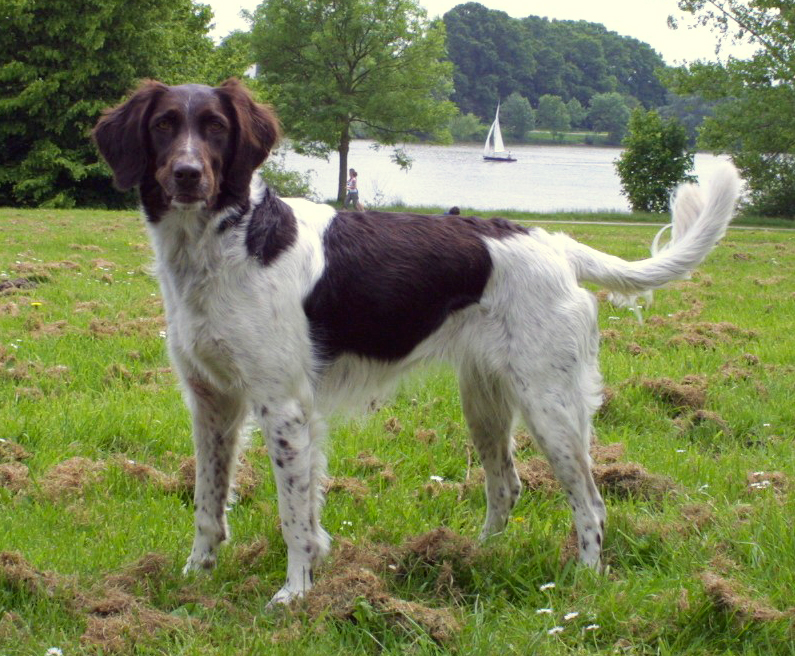- Small Münsterländer
Infobox Dogbreed
country =Germany
altname = Kleiner Münsterländer
Munsterlander (Small)
Kleiner Münsterländer Vorstehhund
Small Munsterlander Pointer
ckcgroup = Miscellaneous
ckcstd = ?
fcigroup = 7
fcinum = 102
fcisection = 1
fcistd = http://www.dogdomain.com/fcistandards/fci-102.htm

image_caption = Kleiner Münsterländer
name = Small Munsterlander
nickname = Moonster
kcukgroup = Gundog
kcukstd = ?
ukcgroup = Gun Dog
ukcstd = http://www.dogdomain.com/fcistandards/fci-102.htm
ckcmisc = yes
note= The United Kennel Club (US) uses the Fédération Cynologique Internationale standard. The Small Munsterlander (SM) (or Kleiner Münsterländer) is a versatile hunting-pointing-retrievingdog breed that reached its current form in the area aroundMünster , Germany. TheLarge Munsterlander is from the same area, but was developed from different breeding stock and is not as closely related as the names would suggest. Small Munsterlanders bear a resemblance to bothspaniel s andsetter s but are rather more versatile. The Small Munsterlander is recognized by theFédération Cynologique Internationale under Group 7, Section 1.2, Continental Pointing Dogs of Spaniel type, and it is related to theEpagneul Français and theDrentsche Patrijshond .Description
Appearance
The breed is often described as about 35 pounds (16 kg) and 18-20 inches (0.45 to 0.5 m) at the shoulder, but the average is somewhat larger, around 45 pounds (20 kg) with some males reaching or slightly exceeding 60 pounds (27 kg) and up to 22 inches (0.55 m). The body is lean yet powerful and not prone to becoming overweight due to an active nature and natural athleticism. Coloration is large patches of brown on a ticked or solid white background. The soft coat is medium length, requiring grooming after hunting in heavy cover or weekly otherwise. The breed is not registered with the
American Kennel Club , which emphasizes appearance over working ability. In the US Small Munsterlanders may be registered with theUnited Kennel Club or the [http://smallmunsterlander.org/ Small Munsterlander Club of North America] .Temperament
Small Munsterlanders are very intelligent, trainable, and attentive but require gentle and patient training, which provides excellent results. They are also strong-willed and an owner who is inconsistent or indecisive might find that his dog is hard to control. Both voice and hand signals are used, and an SM looks back at the hunter for silent signals at intervals when on hold or pointing. They have a very strong drive to follow their keen sense of smell, and thrive with hunting or comparably challenging exercise for an hour or more every day. They love swimming, too. Lack of regular and sufficient exercise and mental challenge will likely result in unwanted behavior, which is common in highly intelligent, driven breeds. They mature rather slowly over 2.5 to 3 years but a well-trained, mature SM is a hunter without peer, and the upland bird hunter hunting over such a dog will enjoy both the experience and great success. The Small Munsterlander is a happy, affectionate family pet when in the house, while remaining a keenly focused, even driven, hunter-pointer-retriever when in the field. They are not suited to life in a
kennel because of their sociable nature and need to interact with people—they need to live in the home of their human family. SMs will pick an individual person to bond most closely with, typically the one who hunts with the dog, but will revel in the company of the rest of the family, too. When raised with other pets in the household, such ascat s, they can coexist happily though they may enjoy a game of chase and point. Unfamiliar small animals outdoors will not be tolerated in the same way.History
Originally a dog bred to work with noble families' falconers before guns were used in bird and small game hunting, ancestors of the Small Munsterlander had to work in upland areas to flush prey for the
falcon , then allow the falcon to keep the prey until the falconer could retrieve it while the dog pointed at the catch. To this day the Small Munsterlander has excellent close searching and pointing drive. With wider availability of guns and personal time for commoners, hunting became more popular, and the breed was further developed as a retriever that worked equally well in the field and water. Owners of the breed consider it to be uniquely effective in working as a team with the huntsman in all phases of the hunt, akin to the close cooperation between a sheep herder andBorder Collie .By the 1800s the breed had fallen into obscurity. Small Munsterlanders were little known, kept by a few families on farms around Munster. For a half century the few dogs that were bred were primarily companions, and used when hunting to feed the family rather than for sport. It developed a local reputation as the dog to have when a hunter's success or failure determined whether his family would have enough to eat. At the end of the 19th century, a concerted effort was made to re-establish the breed from the remaining lines in the Munster region. The fortunate outcome of the companion phase in the Small Munsterlander history was its excellent in-home personality.
Miscellaneous
The Small Munsterlander is rare in the United States, numbering perhaps in the hundreds, and demand from hunters outstrips the number of available dogs, so breeders typically give preference to hunters. They're especially hard to come by for nonhunters there. They are more numerous in
Germany , theNetherlands , and theCzech Republic . SMs excel in nonhunting roles as well because of their exceptional scent-tracking ability, and are used insearch and rescue teams and contraband detection ("drug sniffing") roles as well.In the United Kingdom, the breed is rarer still, with less than 30 dogs known.Fact|date=May 2007 Recognised by The Kennel Club as an imported breed in 2006, they are still to be established in the hunting community.
Other names for this breed: Spion in Germany; and Heidewachtel in the
Netherlands .External links
* [http://www.smallmunsterlander.org/ Small Munsterlander Club of North America]
References
Wikimedia Foundation. 2010.
